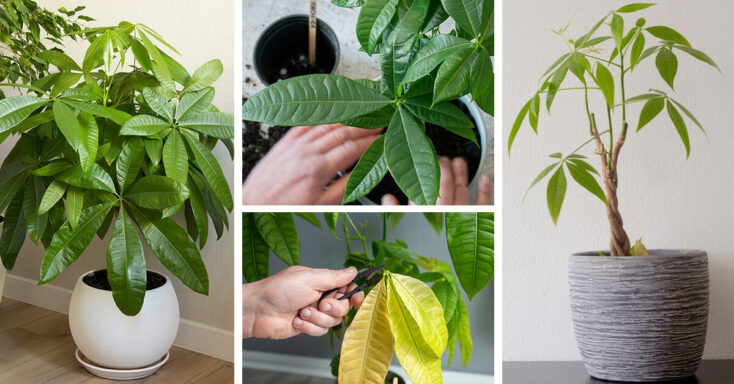Bright green, from a psychological standpoint, is resting and soothing, stressing harmony and tranquility. Associated with growth, renewal, and optimism, is it any wonder that the Money Tree’s bright green foliage just feels “right” as part of your home? It affords a tropical feel to any space without taking over the entire style you have in place.
Key Takeaways
- Psychological Benefits: Bright green color of the Money Tree is soothing and associated with growth, renewal, and optimism, making it an ideal addition to home decor for harmony and tranquility.
- Easy Maintenance and Growth: Money Trees are known as one of the easiest houseplants to grow, adaptable to low light levels, ideal for apartment living, and can reach up to 6 feet indoors.
- Care Instructions: Requires vivid, indirect sunlight, regular watering (allowing soil to dry out between watering), and prefers a temperature range of 65-85°F. Additional humidity benefits the plant, and it thrives in well-draining soil.
- Symbolism and Variety: The braided trunk is a unique feature, often believed to trap fortune, and the plant is available in various types like Bronze Beauty, California Red Tip, and others, each with distinct leaf colors and patterns.
- Pruning and Repotting: Regular pruning encourages fuller growth and shaping; repotting should be done in a larger container with fresh soil. The plant responds well to seasonal changes and is believed to have air-purifying qualities.
The Marvelous Money Tree
Money Trees show up repeatedly on lists of the “easiest houseplants” you can grow. Those living in apartments will be happy to know they don’t mind low light levels. It’s an immediately recognizable element in your indoor garden because of a braided stem adorned with glossy foliage.
When left to their own accord in Central and South America, they reach upward of 60 feet. Don’t worry; an indoor money tree tops out around 6 feet tall. And the little tree is a brassy, tough plant. Some say having one attracts good luck or fortune to your home.
A Noteworthy Happenstance: One legend tells us a poor man prayed for money. He later began growing the money tree and became wealthy from the endeavor. Another story recounts the adventures of a truck driver in Taiwan who had an idea.
He braided the trunk of five little trees in one pot. Now you have the traditional form of the money plant!
Basic Money Tree Care
There are a few tricks to money tree care that lead to success. First is sunlight. The money tree thrives in vivid, indirect sunlight. If you have an east or west-facing window, those are the best in terms of placement.
South works so long as there’s something (like a tree) blocking the fiery noonday sun, protecting them from leaf scorch. If your home is dim, look to an LED grow light to keep the plant healthy.
Money Trees are wetland plants. In an odd dichotomy, the plant doesn’t appreciate soaking wet soil all the time. This means you have to take special care with watering. Make sure your pot has several drain holes.
Every 1-2 weeks, give your plant a good soaking until water seeps through the drainage holes. Now let the soil dry out. If you check your plant and the soil still feels moist, wait. Check again in a few days.
The best household temperature for the Money Tree is 65-85 F. Extra humidity is part of this tree’s care. You can mist it or put it near a humidifier, which, when running, results in a nearly audible “ahh” from the tree.
Money trees don’t require braiding. Nonetheless, a vast majority of money plants on the market have tidy braids. This results in a strong core. Truth be told, the braided tree is actually multiple plants.
While they grow, braiding starts in the trunk (when they are most flexible). Upon competition of one braid, it gets tied by a loose string to hold the shape.
Folklore claims the braided pattern traps fortune. Additionally, the five leaves on each stem correspond. In traditional Chinese medicine, the five leaves on each stem represent metal, wind, water, fire, and earth.
Money Tree Needs
It’s good to get into a rhythm for watering your money tree. Moist soil makes for a thrilled plant. If you overwater by accident, just drain the excess and leave it until the top of the soil feels dry.
While not a “big” need, pruning is good for Money Trees. It actually improves growth for more fullness. This is your opportunity to shape your tree as you wish.
Look for cactus or succulent soil. If that’s not available, seek sandy, peat-based soil. Feed your money tree with fertilizer at least twice a year.
If you notice your plant is growing quickly, it may need an additional boost. If you’re uncertain, please review the instructions on the fertilizer bag.
If you look after your Money Tree’s care instructions and needs, it can live up to a decade.
Encouraging Blossoms on Money Trees: The bloom on a money tree appears in late winter or early spring. Their petals stretch out in a star pattern, colored white or pin. They’re quite showy.
Even so, an indoor money tree rarely flowers. If you want to encourage flowering on a jade plant, keep it rootbound. A small pot works best. Also, lessen water treatments.
Potential Money Tree Varieties for Your Home
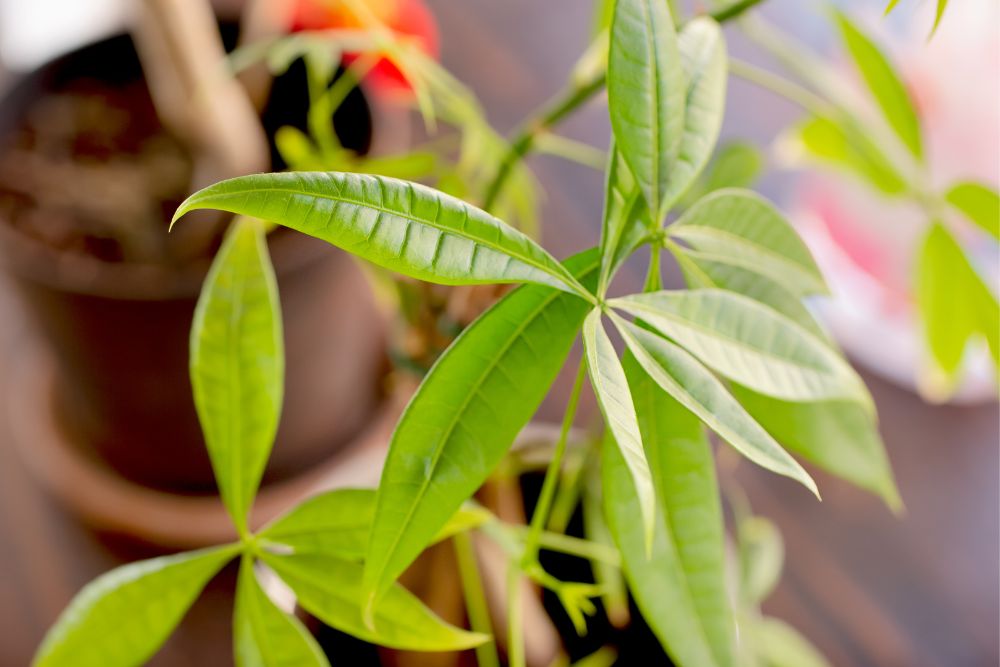
There are dozens of options among Money Trees, one of which would make a cheery addition to your indoor garden. Let’s look at a few.
- Bronze Beauty: True to its name, this plant has copper-green leaves, sometimes with a hint of burgundy. In spring, it produces blue flower spikes. If used outdoors, it makes a pretty ground cover.
- California Red Tip: A flashy plant with pudgy leaves highlighted with purplish-rimmed leaves. The flowers appear in spring, being white and star-shaped. Keep those colors bright by giving it enough full sun. If you don’t have good light, the California Red Tip’s hues decrease in vividness.
- ETs Fingers (Skinny Fingers): One look at this plant tells you why it received this name. ETs Fingers have red-tipped tubular leaves!
- Gollum: bears some similarities to ETs Fingers in that it’s nearly tubular with a red tint at the tippy top of each tube.
- Hobbit: A diminutive plant. Instead of tubes, the leaves look like lime-green cups. The edges are lipstick red. If you’re interested in Bonsai, this is well worth a look.
- Hummel’s Sunset: Spongy round leaves but not ordinary. The foliage has golden-yellow edges. The flower season is fall and winter.
- Sunset: Sometimes called the Golden Money Plant, Sunset features oblong jade-green leaves with just enough yellow and red at the tips to catch your eye.
- Tricolor: Talk about a red diva! The leaves on this plant are thin and long. Edges are ruby red. Sometimes a creamy blush separates the greed from the red.
- Variegata: These are very hard to propagate, meaning they’re a little on the costly side. Each one has a personality all its own, thanks to unique blotches, spatters, and lines of white on the leaves.
If you have a little time while you’re looking, start counting the leaves on the plants you prefer. While the traditional 5-leaf plant attracts positivity, 7-leaf ones are even more powerful. Take a spin at the casino!
Watering Techniques
Ask anyone. Overwatering your Money Plant can easily lead to root rot, which impacts the health of the entire plant. If you notice unabsorbed water on the soil, check the drainage holes in the pot, making sure they’re clear of clutter.
A mistake once in a while won’t kill your plant. But over time, roots soaking in sitting water is a big “no-no”.
On the flip side, it is wholly possible to underwater a Money Tree, too. Droopy leaves are an early sign that your plant is too dry.
Give it a full shower in the sink until water seeps out the bottom. Now get back on track with a watering routine that responds to the plant’s signals.
Potting and Repotting
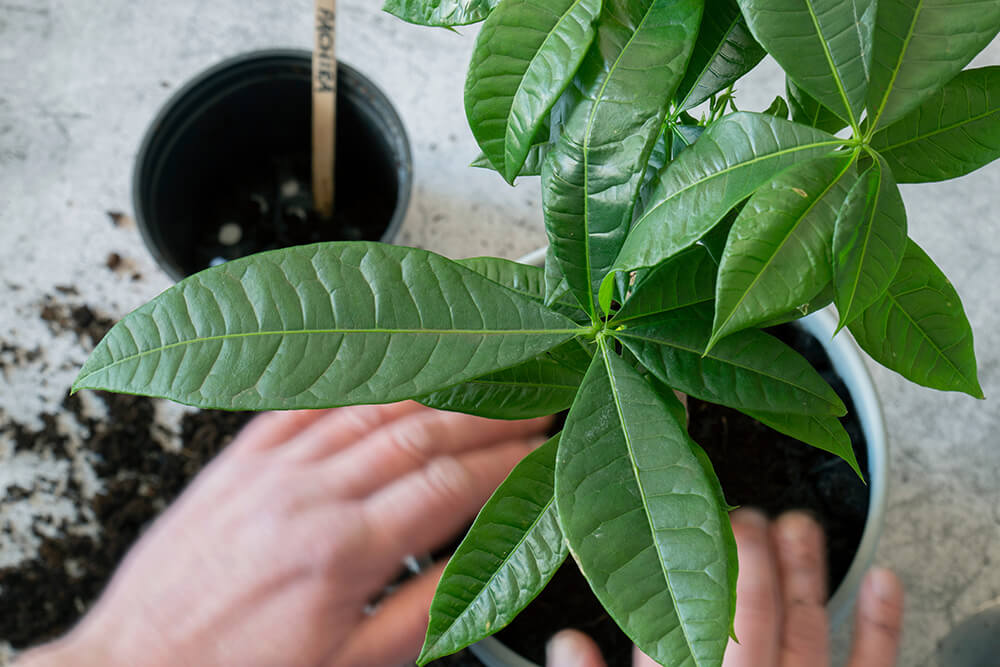
When you buy your money tree, also purchase a suitable home for it. Look for a pot with more than one drainage hole. Start with a 6-inch crock. When you get home, fill the container with nutrient-rich potting soil with peat moss. You can also use any soil suitable for succulents.
Gently pull the plant from the original pot. It’s easiest to do this by turning the container on its side and sliding it out. Use your fingers to loosen the money tree’s roots. Trim back long, thin roots. Put the tree into the soil, and gently press the soil in all around it. Take a step back before you finish to make sure you’ve centered the tree.
Repotting is very similar. Get a larger container (about 2” up), fill it with FRESH soil, and prepare your plant. Repotting is always messy, so you may want to do this in a garage or similar space.
Money plants come from wetlands. There is a way to use that environment as another way of growing your money tree. Take a money plant and put its roots into aquarium water. The leaves must remain on top. Add a few guppies, and you’ve got a floating wonder.
Pruning and Maintenance
Pruning and maintenance typically focus on shaping the tree, including braiding it. If you want to try your hand, you’ll need three young trees with slim trunks. Braid them together before you pot them as a singular plant.
As the stems appear, you add those to the existing symmetry. Place a ribbon where you stop to keep stems together. Don’t go tight. That makes thicker stems.
A Spin on the Dancefloor: You probably won’t be moving your Money Tree often. Once a month, however, turn the pot ¼ of the way to the right. Continue this pattern throughout the year so all sides receive equal amounts of sunlight.
Blooming and Resting Periods
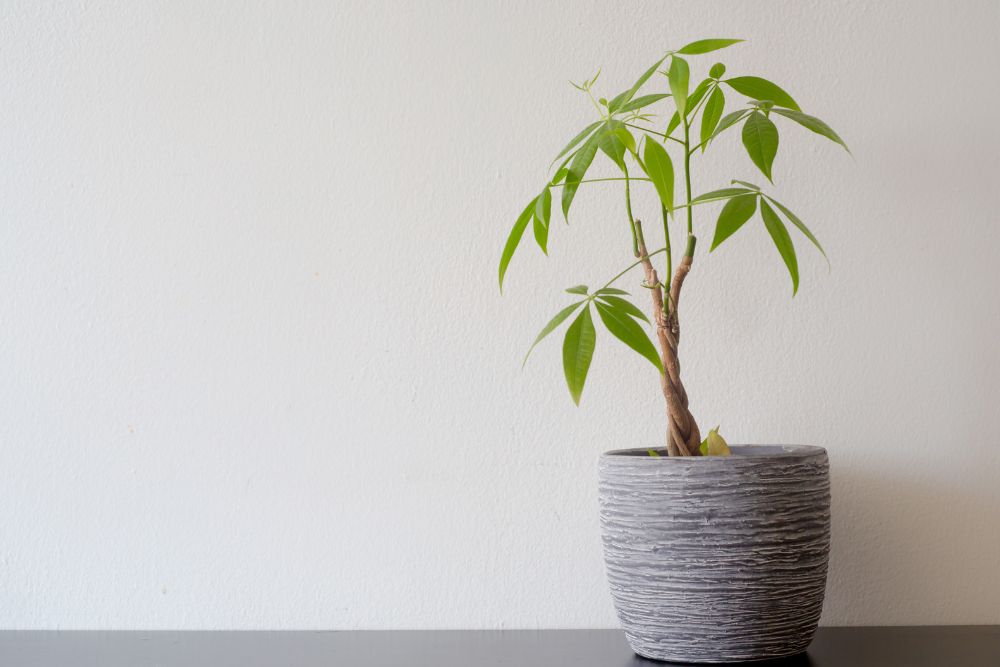
Even indoor plants respond to seasonal changes. Money trees are among them. During colder temperatures, money trees will enter a period of dormancy and hibernation.
It won’t shed all of its leaves, but some dropping is normal, so don’t panic. The plant wants to store energy for spring.
Nature’s Air Freshener: While some experts debate this, many claim the money plant has air-purifying abilities. By absorbing toxins, the quality of air in that area improves. This may contribute to better sleep.
Common Pests & Plant Diseases
The most common insects that target Money Plants are those that enjoy many other flowers in your indoor arrangement. Aphids, spider mites, and mealybugs are the top three. Insecticidal soap helps with all three. You can also take a paper towel with rubbing alcohol and wipe the leaves on top and bottom.
In terms of disease, root rot is at the top of the list. It’s caused by too much moisture. Make sure you are testing the plant’s soil before you water it again.
There are little fruits on the money plant that are, indeed, edible. They taste a lot like a regular fig. You can use them in baking. When ripe, the fruit bursts open from a pod, yielding brownish-red seeds that taste nutty. Young leaves of the money plant are also edible.
Troubleshooting Common Problems
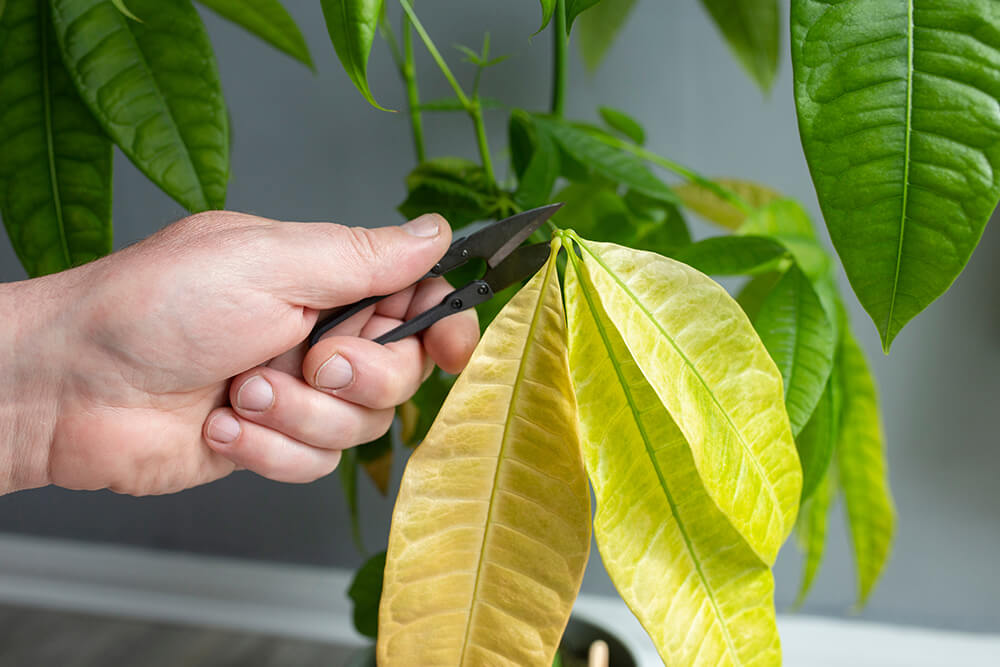
- Yellowing, browning, or curling leaves. These are signs of over-watering, under-watering, or too much sunlight. If the first two options seem fine, try moving the planter to a sunnier location.
- Soft trunks and stems. A sure sign of over-watering.
- Leggy plant. The stems on the plant are stretching for light. Move to a location with more natural sunlight. No new leaf growth is also a symptom of low light conditions.
Keepin’ it Green: The greener your money plant, the more auspicious it is. If you see yellowing leaves, get rid of them immediately, as they can deter your luck and prosperity.
Summary
Whether or not you believe in the powers of the money plant, they have plenty to offer, with an abundance of variety, rich green tones, and hints of color (depending on the type).
The braided trunk sets the plant apart from others in your collection. And, hey, who couldn’t use a little more joy and prosperity?
Frequently Asked Questions About Money Trees
What is a money tree good for?
Unlike many plants related to the Money tree, you can enjoy it in your house with no worry. It’s pet friendly, meaning you won’t be fussing for hours finding a location. Plus, the aesthetics are wholly pleasing.
What is the meaning behind a money tree?
At its beginning in Taiwan, the Money Tree represented prosperity and serendipity. It symbolizes strength, destiny, and power. The way to keep the energy flowing from the money tree is simple. Take good care of it.
Is The Money Tree Plant Lucky?
The answer to this question depends heavily on an individual’s perspective. The tradition is the money tree ensures ongoing success. Of course, no hard-and-fast studies exist. But what does it hurt to allow for the idea of luck saturating our homes?
Money trees are popular wedding gifts. You are offering the recipient the living embodiment of your wish for luck and joy for them. It might also appear at a celebration of a promotion as a gift for the office, bringing success.
Is a money tree a good indoor plant?
Indoor money trees top out at 6-8 feet, with dwarf sizes being smaller. As long as you have the space, the right amount of light and moisture, and good humidity, the money tree is a good indoor plant.
Should I shower my money tree?
An occasional shower in warm water not only keeps the money tree’s leaves clean but also shakes off any unseen pests. This tree does like a good soak, but always dry it out in between.
Can I put my money tree in the bathroom?
Yes. Money trees like high humidity, so the bathroom might be the best location for the plant. Feng Shui considers this a prime location for Money trees because it mimics their natural habitat.

